-

人教版高中英语必修1Anne's best friend说课稿
Step 7 Language points 1.Vocabulary (1) go through (2) set down (3) a series of (4) on purpose (5) in order to (6)at dusk (7)entirely (8)face to face 2.Important sentences (1)…I’ve grown so crazy about everything to do with nature. (2)There was a time when … (3)I stayed awake on purpose until … (4)It was the first time … that I’d seen the night … (5)It’s no pleasure looking through … Purpose: 1.Master the required vocabulary and sentence structures. 2.Use them freely. Step 8 Consolidation 1.Find out the topic sentences 2.Retell the text according to the topic sentences Purpose: I want to know if my students understand the text. Step 9 Discussion Imagine you have to go into hiding like Anne and her family, what would you miss most? Giveyour reasons. Purpose: Train Ss’ oral English ability. Step 10 Homework Write an article on Friends. Purpose: 1. Improve the Ss’ writing ability. 2 Train the Ss’ ability of self—teaching and looking up information by themselves. Part 5 Blackboard design(说板书设计)Unit 1 Friendship Reading Anne’s Best Friend 1.Main idea of each paragraph: Para. 1 Anne made her diary her best friend. Para .2 Anne wrote her feelings in her diary. Para .3 Anne missed nature. Para.4 Anne saw the night face to face Para.5 Anne wanted to experience nature outdoors. 2.Listening: Exx.1 P3 3.Discussion: Exx.3 P3 Purpose: 1.Make Ss familiar with the passage 2.Make the design inductive, instructive and artistic.

人教版高中英语必修2Computers说课稿3篇
一. 教材分析1. 本单元的中心话题是“计算机(Computers)”,内容涉及计算机的发展历史,计算机的应用等。本节课是该单元的第一课时,我将Warming up, Pre-reading and Comprehending这四部分整合为一节精读课。其中。Reading部分是题为WHO AM I?的文章,以第一人称的拟人手法介绍了计算机发长演变的历史和计算机在各个领域的应用,其主旨是表达计算机的发展变化之快以及在生活中用途之广。而Warming up部分以图片的形式展现了计算机的发展历程;Pre-reading中的问题和排序分别是为了预测语篇的内容和测试学生对计算机历史了解的情况;Comprehending则通过各项练习训练学生的阅读技能,从而加深对文章的理解。可见这几部分是一个有机的整体。2. 教学目标:1) 语言目标:重点词汇及短语:abacus, calculate, calculator, PC, laptop, PDA, robot, analytical, technological, universal, mathematical, artificial, intelligent, network, explore, in common, as a result.重点句子:a. My real father was Alan Turing, who in 1963 wrote a book to describe how computers could be made to work, and build a “universal machine” to solve any mathematical problem.

人教版高中英语必修3Astronomy the science of the stars说课稿3篇
Step 2 Pre-listeningAfter students finish their discussion, I will show a picture of Newton and ask them: Who is him? What is he famous for? Could you find out some words to describe him? Maybe students will answer that he is genius for his finding of theGravitation, making a great contribution to the progress of human being. At that time I will show another two pictures of Einstein and Hawking, letting students guess who they are and write down their idea about the Gravitation. For I have arranged them to search more information about the gravity before this class, Students have beenfamiliar with the topic and will not be afraid about this abstract conception, which is helpful for their listening.Step 3 While-listeningIn this step, students will be required to listen the material for three times. The first and listening is extensive listening and the second and third listening is intensive listening. In the first time, They are required to listen a material including Part 1 and Part 2 and choose the best summary of the listening text. After they choose the right answer, They also need work in group to explain what is wrong with the others. Then I will make a conclusion that we should pay attention to the first paragraph and last paragraph and some keys to get the main idea. By doing this, their capacity of generalization will have a great improvement.Before the second listening, I will ask students to scan the blank on the power point quickly and ask them to note down some key words .Then ask them to listen to the Part 1again and fill the first column of the chart. Maybe some students just show the ideas of these three scientists an still can’t catch their development of gravity. Therefore, I will ask them to listen to Part 2 again and fill in the rest. After finish the listening, I will give them ten minutes to discuss with their partner. I will also guidethem to improve their answers when they discuss with others.

人教版高中英语必修4A taste of English Humor说课稿3篇
Then I would ask them to think of a funny English or Chinese and tell it to partners. While telling stories, they can use expressions and some acting to help make the story funny. 5 minutes would be given to do this.Those stories they told there will be the material for their writing. Soletting them tell it at first is helpful. And they can make a difference between telling a funny story and writing it down. Generally speaking, it is difficult forstudents to write well because they don’t know what to write and how to write. Asking them to tell their own stories at first can help them come up with what to write.After their telling, I would invite someone to share his/her story with all of us and I would write it down on the blackboard.This example story would be used as a sample to illustrate the format of funny story. Different from a story from teacher or textbook, a story from students can obviously become a interesting material to draw students’ attention.Then I would ask the whole class to put this story into several parts. It might be a little bit difficult for them. So I would ask them to find out whether all the sentences are necessary. After delete some sentences, there are 6 sentences left behind. Then they can easily put them into three parts. After interaction with students, I would teach them the right terms for each part and conclude the format of funny story.This step is the key and difficult point in my lesson. So I mainly usetask-based teaching method in this part and the task for students was divided into several stages. With the separated difficult level, students can find there are usually three parts in writing. They can also learn to write without the unnecessary parts in the process of analyzing. And then I wouldn’t rush to tell them the right terms to them directly. Instead, I would ask them to name them by their own. A confused mind is better for acquiring knowledge.While-writing:Then I would give students 7 minutes to write down this story, without other requirements.With all the preparations in pre-writing, students’ difficulties were cleared. So it would be much easier for them to write down the story within 7 minutes. There are no other requirements because students’ first writing is actually a drafting. It would be revise and edit several times later. Writing, as a skill

人教版高中英语必修3Festivals around the World说课稿3篇
Teaching plan for Unit 1 book3Good morning, teachers. It’s my great pleasure to be here because I can share my lesson with you and I can learn a lot from it. I’ll begin my lesson from the following four parts, the teaching material, the teaching methods, the studying methods and the teaching procedure.Firstly, let me talk about the teaching material. The content of my lesson is the reading passage festivals and celebrations of Unit 1 Festivals around the world. This passage is about festivals and celebrations. By studying this passage, we’ll enable the students to know that festivals exit everywhere, and many of festivals in different countries celebrate similar ideas. As we all know, the reading passage is the center of each unit. If the Ss can learn it well, it will be helpful to make the Ss learn the rest of this unit.After studying the teaching material, I think the teaching aims are as the followings:1. Knowledge aims:(1) The Ss can master the usage of the important words andexpressions.(2)The Ss can use the __________________ (grammar) in the proper situation.Make students know about the festivals all over the world and the detail of the festivals, such as origin, content, and the date of the holiday festivals.2. Ability aims:(1) Students can talk about festivals and celebrations in English(2) To improve the student’s reading ability, especially their skimming and scanning ability.3. Emotion aims:Make the Ss know about the foreign festivals, and respect other countries’ custom.Next, let’s come to the important points and the difficult points.The important point is how to make the Ss understand the text better and the difficult point is how can they talk about it. secondly, Teaching Methods:1. task-based Language Teaching2. Computer assisted language teaching.3. question-and–answer methodThirdly, Studying Methods:

人教版高中英语必修3Healthy Eating说课稿4篇
Language learning needs a context, which can help the learners to understand the language and then can product comprehensible output, so computer has the advantages to make the materials attractive.Part 3 Learning MethodsTask-based, self-dependent and cooperative learningPart 4 Teaching ProcedureStep One Lead-in“Interest is the best teacher.” Therefore, at the very beginning of the class, I should spark the students’ mind to focus on the centre topic “the band”. I’ll show some pictures of food to attract their attention and then bring some questions.Question:What kind of food they like?What should go into a good meal?The answers must relate to the diet. After this, the students will be eager to know something about a balance diet and this is the very time to naturally lead the class into Step 2Step 2 Reading for information: skimming and scanning In this step, I use Task-based Language Teaching method, which can give students a clear and specific purpose while skimming and scanning the context.Task 1 General ideaThe students will be asked to just glance at the title and the pictures of the passage, and then guess what they will read in the text. And they’ll be divided into groups of four to have a discussion.The purpose is to inspire the students to read actively, not passively. In addition, the task is to develop the students’ reading skill by making prediction and to encourage the students to express their thoughts in English and cooperate with each other.Task 2 Main idea of each paragraphCooperative learning can raise the students’ interest and create an atmosphere of achievement. Based on this theory, I divide the whole class into 4 groups to skim the whole text and get the main idea of each paragraph.

人教版高中英语必修5First aid说课稿6篇
In this class, I have 3 teaching aims, that is, knowledge aims, ability aims and emotion aims.1) Knowledge-Teach students new words and expressions, such as temporary, bleed,sprain choke, first aid, fall ill and so on.-Enable students to have a better understanding for some basic knowledge of first aid.2) Ability-Train students’ speaking, reading and writing abilities by different teaching activities, such as skimming, comprehending, team work, role play, retelling and writing.-Develop students’ reading strategy on how to move general idea to specific information.3) Emotion-Promote students’ awareness of giving first aid.- Cultivate students’ creativities.Then let’s come to my teaching methods and activities.III. Teaching methods and activities:To achieve different teaching aims, various kinds of teaching methods and activities will be adopted throughout this period, such as TBL (task-based learning), skimming, team work, brainstorm and others, which can offer students opportunities to fulfill tasks in which they can use language to achieve a specific outcome.IV. Teaching aids:Computer and blackboardV. Teaching important points:1) Make students have a clear mind for the structure of the text.2) Help students understand the theme of the text.VI. Teaching difficulties:1) So many new words may affect students’ understanding.2) How to get students to know about the functions of the skin and thecauses, characteristics and treatments for different degree burns,and the knowledge about giving first aid. VII. Blackboard design:

人教版高中英语必修5Life in the Future说课稿5篇
Good afternoon, everyone. It’s my great pleasure to be here sharing my lesson with you. The content of my lesson is Senior English for China Book5 Unit 3 Life in the Future. I’ll be ready to begin this lesson from six parts: Analysis of the teaching material, Analysis of the students, Teaching aims and important and difficult points, Teaching methods and aids, Teaching procedures, and Blackboard design. First, let me talk about the teaching material.Part 1 Analysis of the Teaching Material:This unit is about what human beings’ life will be like in about one thousand years. By studying of this unit, we’ll Enable the students to know the changes in humans’ life and some new inventions bringing about the change and develop the interest in science. This lesson plays an important part in the English teaching in this unit. This is an important lesson in Book Five. From this lesson, it starts asking the Ss to grasp contents of each passage. Therefore, this lesson is in the important position of the teaching material. If the Ss can learn it well, it will be helpful to make the Ss learn the rest of this unit.Part 2 Analysis of the SsAs Senior2 Ss, they are at different levels of English fluency, some of them have lost interest in English. So during the lesson, I arrange a variety of activities to let all of them join in to attract their interest and let them be confident and taste the joy of success.
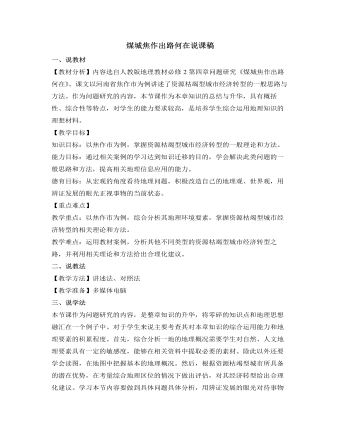
人教版高中地理必修2煤城焦作出路何在说课稿
分析过焦作市的地理概况和产业优势后,就需要针对由于资源枯竭所带来的问题提出合理化的建议。既然是谈经济转型,就应该将话题的范围明确在这一领域内。通过材料3的相关内容,我们了解到焦作市需要在产业结构调整、培育新的优势产业、增强综合竞争力等三个整改方针上下功夫。因而引导学生针对优势与不足提出建议,以三个整改方针为基准,衡量建议的可行性是锻炼学生解决此类问题的有效途径。在此我将教会学生的是解决问题方法而非案例的内容,正所谓“授之以鱼,不如授之以渔”。接下来针对学生的建议和教材资料分析所罗列的10点整改思路,由学生自由发言提出看法,通过教师的指导和学生的讨论,进而确定经济转型建议的具体方案。最后注意将建议与产业优势相对照,看建议是否都是围绕着产业优势而提出的,这样做会加深学生的印象,通过建议和优势的对应关系,将不难找出此类问题的解题思路。
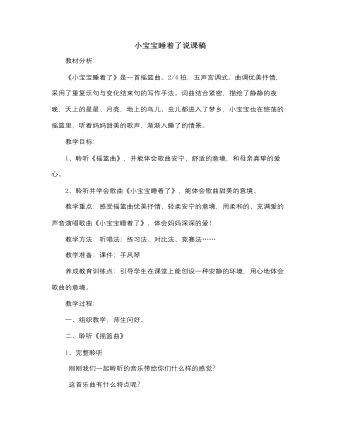
人音版小学音乐一年级下小宝宝睡着了说课稿
三、聆听、表演《小宝宝睡着了》 1、聆听歌曲启发学生说说听到歌曲时感受到了什么?2、复听,跟着歌曲,轻柔地拍节拍。 3、听琴声逐句学唱歌曲。 4、指导学生用连贯、轻柔的声音,唱准、唱好歌曲。 5、重点引导学生说说结尾的处理方式——对比练习,看哪一种方法更恰当 6、引导学生用自己创作的方式为歌曲伴奏、伴舞。 四、小结。 教学反思:一年级课堂上会有一些学生在上课的时候出现喊唱的现象,我在歌曲处理这一环节对歌曲的意境作了这样的描述:静静的夜晚,天上的星星睡了、月亮睡了、地上的鸟儿、虫儿也都进入了梦乡,小宝宝也在悠荡的摇篮里,听着妈妈甜美的歌声,渐渐入睡了。同学们妈妈哄宝宝睡觉唱歌的声音应该是欢快的,还是轻柔的?经过我的描绘和讲解学生理解了在演唱摇篮曲时应该用轻柔的声音,要把每一句都连贯的唱起来,不仅句与句之间要连贯,第一、第二段也要衔接紧凑,轻轻的哼唱出来,体会妈妈哄小宝宝睡觉时是多么的温柔。
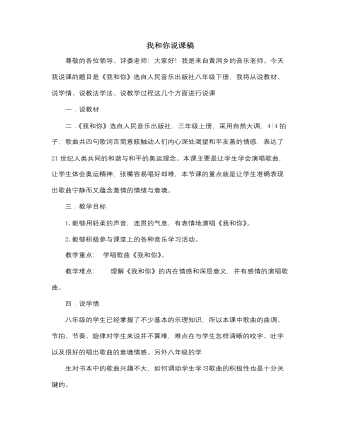
人音版小学音乐三年级上册我和你说课稿
6.欣赏第二版本。 师:关于歌曲《我和你》,还有一个鲜为人知的小故事,歌曲的原唱其实另有他人。最初作曲家陈其钢选了非常有实力的两位歌坛新秀来演唱,导演张艺谋认为一定要选择知名度很高的歌手,两人还因此大吵了一架,据说原唱的歌声更加轻盈,更加动听,你们想听一听吗?7.演唱常石磊版。 师:大家知道了,为了更好地表现出这首歌的宁静简单的气质,我们的演唱要最大限度地轻盈、柔和,就像天使的声音一样纯净。下面该轮到同学们来演唱了。注意眼睛看老师的手势,控制好气息,有表情地演唱。8.钢琴伴奏演唱。师:通过演唱,同学们肯定都感受到了这首歌曲的动人之处。下面我想请同学们站起来,想象我们来到宽敞的户外,把心放在天地间,让我们跟着钢琴伴奏,用我们纯净美妙的歌声来演绎。
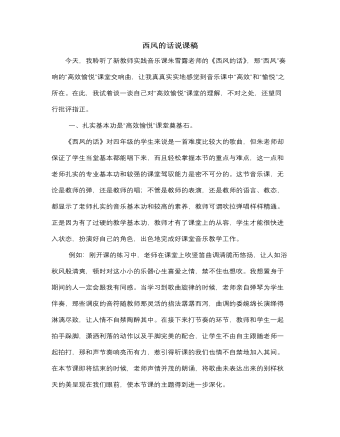
人音版小学音乐四年级下册西风的话说课稿
课堂上随机给出鼓励和肯定的语言更显教师的亲和力,营造出一个自由、民主的课堂教学氛围。如:“你很棒”“说得太好了”“掌声鼓励”等等,听似平淡无奇,但结合那时那景则显得老师语言的朴实与自然,学生同老师间的默契与和谐。听完朱老师执教的《西风的话》一课,通过认真反思我真切认识到:一堂好课是否愉悦高效,就看教师是否真正用心的地去诠释作品,真正用心地去备课。孙老师执教的《西风的话》平实、淡雅,教师教态自然大气,言谈中充满着激情,让我们的心不自觉跟着一起走。我想不出什么华丽的词藻来描述这堂课,但我却深深地被吸引,这应该就是生命课堂的魅力所在吧。听了孙老师执教的《西风的话》后收获很多,能于言表的也还没有表达充分,但更多的是带给我的触动和对自己所教学科如何“高效愉悦”的思索。也希望凭借着“高效愉悦”课堂活动的深入开展,让自己的美术课堂灵动起来,让我们的课堂真正成为孩子们探求知识的乐园。
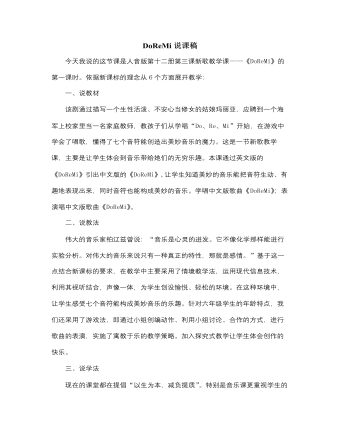
人音版小学音乐六年级下册DoReMi说课稿
1.通过欣赏《DO RE Mi》的影片,调动学生的积极性,增强学生学习新歌的兴趣。2.了解电影。任何一首歌曲都有着不一样的故事,通过文字简介,能够帮助学生深入歌曲的学习,升华表演的情绪。然后通过聆听歌曲《DO RE MI》,师范唱,生听唱,师指导唱的形式来帮助学生继续领略音乐的魅力。7.音乐游戏。不仅将学生分成七个小组跟琴演唱,还让学生根据伴奏完成歌曲接龙,充分体现了学生在课堂中的主体性。8.拓展开发。通过了解柯尔文手势,电影的背景资料和歌曲《孤独的牧羊人》的欣赏,提高学生的能力。第二环节既是这节课的重点,也是难点,通过引导学生运用手势音阶和肢体语言来表演歌曲《DoReMi》,又通过小组合作的方式突破难点。最后小结,简单地总结了同学们的表演让所有人感受到音乐带给我们的无穷乐趣,七个音乐字母构成了美妙的音乐,最后在美妙的音乐中结束了这节课!
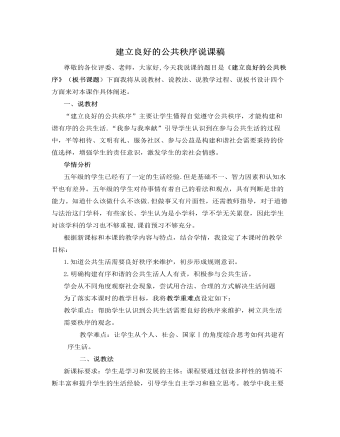
人教部编版道德与法制五年级下册建立良好的公共秩序说课稿
教师小结:同学们,通过刚才的讨论,我们明白了只有大家共同遵守规则,才能创造和谐文明的社会环境,正如著名学者莱蒙特所说的:“世界上的一切都必须按照一定的规矩秩序各就各位。”(六)、课堂总结师:通过今天对《建立良好的公共秩序》这一课的学习,我们懂得了什么?在生回答的基础上师进一步谈话:生活中有许多看起来是微不足道的事情,实际上都同社会的主产、生活乃至每个社会成员的工作、学习、生活密不可分,如果一个社会的公共秩序受到了破坏,这个社会的正常生产和生活也就受到极大的影响,社会风气就会颓败,反之如果一个社会的每个成员都学法、懂法、守法、护法,拥有一个良好的公共秩序,那么社会就会有条有理,井然有序,因此建立一个良好的社会公共秩序,是我们大家的迫切希望,希望同学们从我做起,从现在做起,认真遵守公共秩序吧!
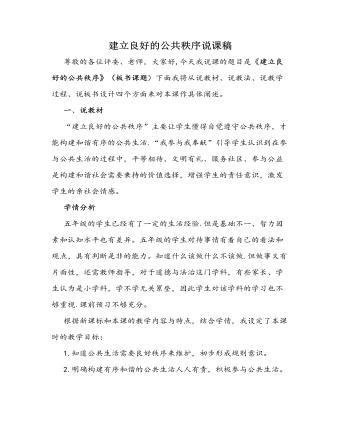
人教部编版道德与法制五年级下册新版建立良好的公共秩序说课稿
教师小结:同学们,通过刚才的讨论,我们明白了只有大家共同遵守规则,才能创造和谐文明的社会环境,正如著名学者莱蒙特所说的:“世界上的一切都必须按照一定的规矩秩序各就各位。”(六)、课堂总结师:通过今天对《建立良好的公共秩序》这一课的学习,我们懂得了什么?在生回答的基础上师进一步谈话:生活中有许多看起来是微不足道的事情,实际上都同社会的主产、生活乃至每个社会成员的工作、学习、生活密不可分,如果一个社会的公共秩序受到了破坏,这个社会的正常生产和生活也就受到极大的影响,社会风气就会颓败,反之如果一个社会的每个成员都学法、懂法、守法、护法,拥有一个良好的公共秩序,那么社会就会有条有理,井然有序,因此建立一个良好的社会公共秩序,是我们大家的迫切希望,希望同学们从我做起,从现在做起,认真遵守公共秩序吧!

人音版小学音乐二年级上册彝家娃娃真幸福说课稿
环节四:拓展延伸感悟彝乐这是对所学内容进行反馈、提高的过程。学生利用在课中收集到的信息选出一首彝族民歌来,然后在一曲《远方的客人请你留下来》中跟彝家娃娃说再见。本课亮点:一、轻快活泼的声音和准确的学唱始终是同时进行并完成的,即唱好歌是在唱会歌中体现的,歌曲的处理和表达是在学习歌曲的过程中完成的,会唱歌是在唱好歌中生成的,三者融为一体,同时达成目标。二、根据歌曲演唱和情绪调动的不同视听需要,将综合了的人文信息点状散发,极具艺术性地分插到每个环节中,恰当地处理了音乐和人文的关系。三、在整节课浓郁的情境体验中,学生似乎真正进入了彝家山寨,和彝家娃娃一起学唱歌、学说彝语、学跳舞并且欢度了一个开心的火把节。
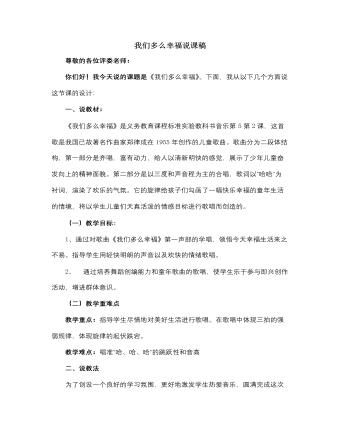
人音版小学音乐三年级上册我们多么幸福说课稿
教师有感情的教唱歌曲,学生感受歌曲的情绪、节奏、节拍的同时跟着学唱。在这基础上学唱歌词,随琴听唱,要求注意 3/4 拍的强弱规律, 请同学们打拍子随老师一起唱,再组织同学们积极参与课堂活动,教师给予评价。(3)随歌起舞美的旋律、美的歌词更需要美的舞姿。为了激发音乐学习兴趣,我在本歌曲完全好以后,让学生们用舞蹈来表现歌曲,组织学生通过自主合作、互相启迪、探讨来再现歌曲并进行歌舞创编。教师给予启发和指导舞蹈动作,强化老师参与者和合作者的身份,体现师生融洽关系。(三)总结同学们这节课开心吗?这样的学习生活幸福吗?那我们要珍惜这份幸福,让我们再次唱响幸福,为幸福喝彩。(播放歌曲,让学生听着或唱着,带着愉快的心情去享受课间活动的快乐。)
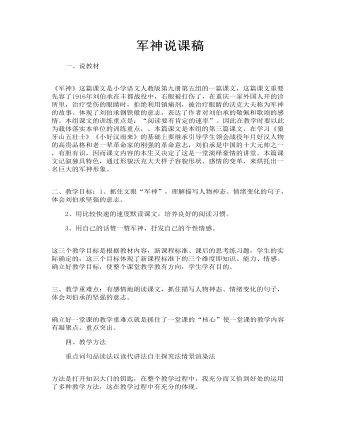
军神说课稿
二、教学目标:1、抓住文眼“军神”,理解描写人物神态、情绪变化的句子,体会刘伯承坚强的意志。 2、用比较快速的速度默读课文,培养良好的阅读习惯。 3、用自己的话赞一赞军神,抒发自己的个性情感。 这三个教学目标是根据教材内容,新课程标准、课后的思考练习题,学生的实际确定的,这三个目标体现了新课程标准下的三个维度即知识、能力、情感。确立好教学目标,使整个课堂教学教有方向,学生学有目的。 三、教学重难点:有感情地朗读课文,抓住描写人物神态、情绪变化的句子,体会刘伯承的坚强的意志。 确立好一堂课的教学重难点就是抓住了一堂课的“核心”使一堂课的教学内容有凝聚点,重点突出。 四、教学方法 重点词句品读法以读代讲法自主探究法情景渲染法 方法是打开知识大门的钥匙,在整个教学过程中,我充分而又恰到好处的运用了多种教学方法,这在教学过程中有充分的体现。
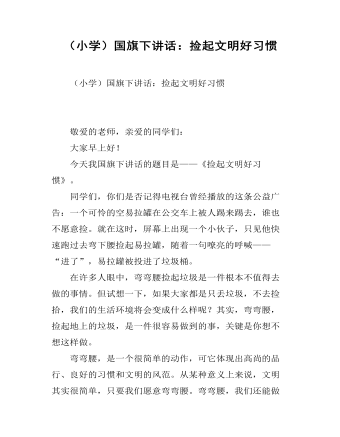
(小学)国旗下讲话:捡起文明好习惯
同学们,你们是否记得电视台曾经播放的这条公益广告:一个可怜的空易拉罐在公交车上被人踢来踢去,谁也不愿意捡。就在这时,屏幕上出现一个小伙子,只见他快速跑过去弯下腰捡起易拉罐,随着一句嘹亮的呼喊——“进了”,易拉罐被投进了垃圾桶。在许多人眼中,弯弯腰捡起垃圾是一件根本不值得去做的事情。但试想一下,如果大家都是只丢垃圾,不去捡拾,我们的生活环境将会变成什么样呢?其实,弯弯腰,捡起地上的垃圾,是一件很容易做到的事,关键是你想不想这样做。弯弯腰,是一个很简单的动作,可它体现出高尚的品行、良好的习惯和文明的风范。从某种意义上来说,文明其实很简单,只要我们愿意弯弯腰。弯弯腰,我们还能做许多事:弯弯腰,随手捡起同学掉下的铅笔;弯弯腰,鞠躬向老师问声好;弯弯腰,扶起摔倒的小同学
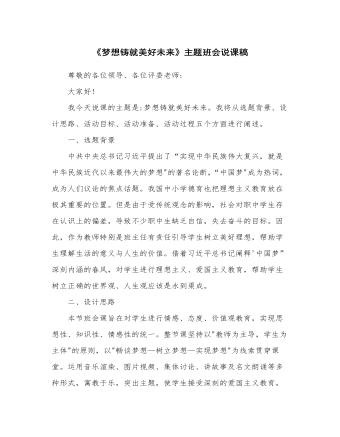
《梦想铸就美好未来》主题班会说课稿
第2步:学生表演小品《今天的幸福》。指导学生在观赏小品的同时感悟小品折射出的思想意义,理解个人梦想与国家梦想之间的关系。个人梦想与国家梦想就像是一滴水之于一条江,涓涓细流汇成了江河湖泊,江河湖泊牵引着涓涓细流。基于以上两步学生对梦想内涵的认识,第3步:结合教育部开展的全国中等职业学校”文明风采"大赛活动,抓住职校生的专业特色,在班级开展"职业生涯规划”设计比赛,并在课前遴选出的优秀设计作品,课堂上进行全班讨论交流,评选出最佳设计。这个环节我引导学生将职业生涯规划的设计与梦想活动有机结合,加强学生的职业意识,树立正确的职业理想,为未来实现梦想迈出关键的第一步。这个板块以直观的图片、有趣的小品及充满竟争意识的设计评选这些符合职中生认知水平和心理特点的形式,激发学生兴趣,寓教于乐,让学生在观赏品评中理解梦想的内涵,树立正确的职业梦想。